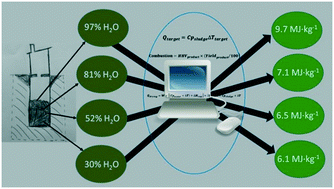当前位置:
X-MOL 学术
›
Environ. Sci.: Water Res. Technol.
›
论文详情
Our official English website, www.x-mol.net, welcomes your
feedback! (Note: you will need to create a separate account there.)
The feasibility of char and bio-oil production from pyrolysis of pit latrine sludge
Environmental Science: Water Research & Technology ( IF 3.5 ) Pub Date : 2017-07-03 00:00:00 , DOI: 10.1039/c7ew00132k Tom Bond 1, 2, 3, 4 , Queenie Tse 1, 4, 5, 6 , Clementine L. Chambon 4, 5, 6, 7 , Paul Fennell 4, 5, 6, 7 , Geoff D. Fowler 1, 4, 5, 6 , Michael R. Templeton 1, 4, 5, 6
Environmental Science: Water Research & Technology ( IF 3.5 ) Pub Date : 2017-07-03 00:00:00 , DOI: 10.1039/c7ew00132k Tom Bond 1, 2, 3, 4 , Queenie Tse 1, 4, 5, 6 , Clementine L. Chambon 4, 5, 6, 7 , Paul Fennell 4, 5, 6, 7 , Geoff D. Fowler 1, 4, 5, 6 , Michael R. Templeton 1, 4, 5, 6
Affiliation

|
Sustainable methods are required in developing regions to treat and recover value from pit latrine sludge. One potential strategy is to pyrolyse pit latrine contents and generate char and bio-oil, which can then be used as a soil enhancer and fuel, respectively. Despite the many benefits associated with the process, there is very limited relevant literature available. This study examines its feasibility. Initially, the energy balance associated with pyrolysis of sewage sludge was calculated using data from 14 literature studies. For dewatered sewage sludge, the average energy input required during drying and pyrolysis 2.9 ± 0.2 MJ kg−1 sludge, while the average net energy recovered from combustion of bio-oil was 6.9 ± 0.2 MJ kg−1. For sewage sludge which had been dewatered and dried prior to pyrolysis equivalent values were 1.2 ± 0.2 MJ kg−1 and 8.5 ± 0.9 MJ kg−1. Parallel calculations were then undertaken with pit latrine sludge as the hypothetical feedstock, assuming a water content of 30, 52, 82 or 97% wt. The energy input required was 2.1, 2.6, 3.3 and 3.6 MJ kg−1, respectively. Corresponding net energy recoveries from pyrolysis combined with use of the resultant bio-oil as fuel were 9.7 ± 0.8, 7.1 ± 0.8, 6.5 ± 0.8 and 6.1 ± 0.8 MJ kg−1. Char production is more favorable from stabilised pit latrine sludge with lower moisture and volatile solids content. Barriers to pyrolysis of pit latrine sludge are discussed, including the heterogeneity of pit latrine composition and the difficulty of collecting high-viscosity sludge. Overall, this study demonstrates the potential that pyrolysis has as a disposal and value addition method for pit latrine sludge. Innovative methods for sludge drying and pit emptying will expedite the process becoming a reality.
中文翻译:

坑厕污泥热解生产焦炭和生物油的可行性
在发展中地区,需要采取可持续的方法来处理和回收坑厕污泥的价值。一种潜在的策略是热解坑厕中的内容物并生成炭和生物油,然后分别将其用作土壤改良剂和燃料。尽管与该过程相关的好处很多,但相关文献很少。这项研究检验了其可行性。最初,使用来自14项文献研究的数据计算了与污水污泥热解相关的能量平衡。对于脱水的污水污泥,在干燥和热解过程中所需的平均能量输入为2.9±0.2 MJ kg -1污泥,而从生物油燃烧回收的平均净能量为6.9±0.2 MJ kg -1。对于在热解之前已经脱水和干燥的污水污泥,当量值分别为1.2±0.2 MJ kg -1和8.5±0.9 MJ kg -1。假设水含量为30%,52%,82%或97%(重量),则使用坑厕污泥作为假设的原料进行并行计算。所需的能量输入分别为2.1、2.6、3.3和3.6MJ kg -1。结合使用所得生物油作为燃料,热解得到的相应净能量回收为9.7±0.8、7.1±0.8、6.5±0.8和6.1±0.8 MJ kg -1。稳定的矿井厕所污泥具有较低的水分和挥发性固体含量,更有利于焦炭的生产。讨论了坑厕污泥热解的障碍,包括坑厕成分的异质性和收集高粘度污泥的困难。总的来说,这项研究表明了热解技术作为坑厕污泥的处置和增值方法的潜力。污泥干燥和排空的创新方法将加快该过程的实现。
更新日期:2017-08-03
中文翻译:

坑厕污泥热解生产焦炭和生物油的可行性
在发展中地区,需要采取可持续的方法来处理和回收坑厕污泥的价值。一种潜在的策略是热解坑厕中的内容物并生成炭和生物油,然后分别将其用作土壤改良剂和燃料。尽管与该过程相关的好处很多,但相关文献很少。这项研究检验了其可行性。最初,使用来自14项文献研究的数据计算了与污水污泥热解相关的能量平衡。对于脱水的污水污泥,在干燥和热解过程中所需的平均能量输入为2.9±0.2 MJ kg -1污泥,而从生物油燃烧回收的平均净能量为6.9±0.2 MJ kg -1。对于在热解之前已经脱水和干燥的污水污泥,当量值分别为1.2±0.2 MJ kg -1和8.5±0.9 MJ kg -1。假设水含量为30%,52%,82%或97%(重量),则使用坑厕污泥作为假设的原料进行并行计算。所需的能量输入分别为2.1、2.6、3.3和3.6MJ kg -1。结合使用所得生物油作为燃料,热解得到的相应净能量回收为9.7±0.8、7.1±0.8、6.5±0.8和6.1±0.8 MJ kg -1。稳定的矿井厕所污泥具有较低的水分和挥发性固体含量,更有利于焦炭的生产。讨论了坑厕污泥热解的障碍,包括坑厕成分的异质性和收集高粘度污泥的困难。总的来说,这项研究表明了热解技术作为坑厕污泥的处置和增值方法的潜力。污泥干燥和排空的创新方法将加快该过程的实现。











































 京公网安备 11010802027423号
京公网安备 11010802027423号